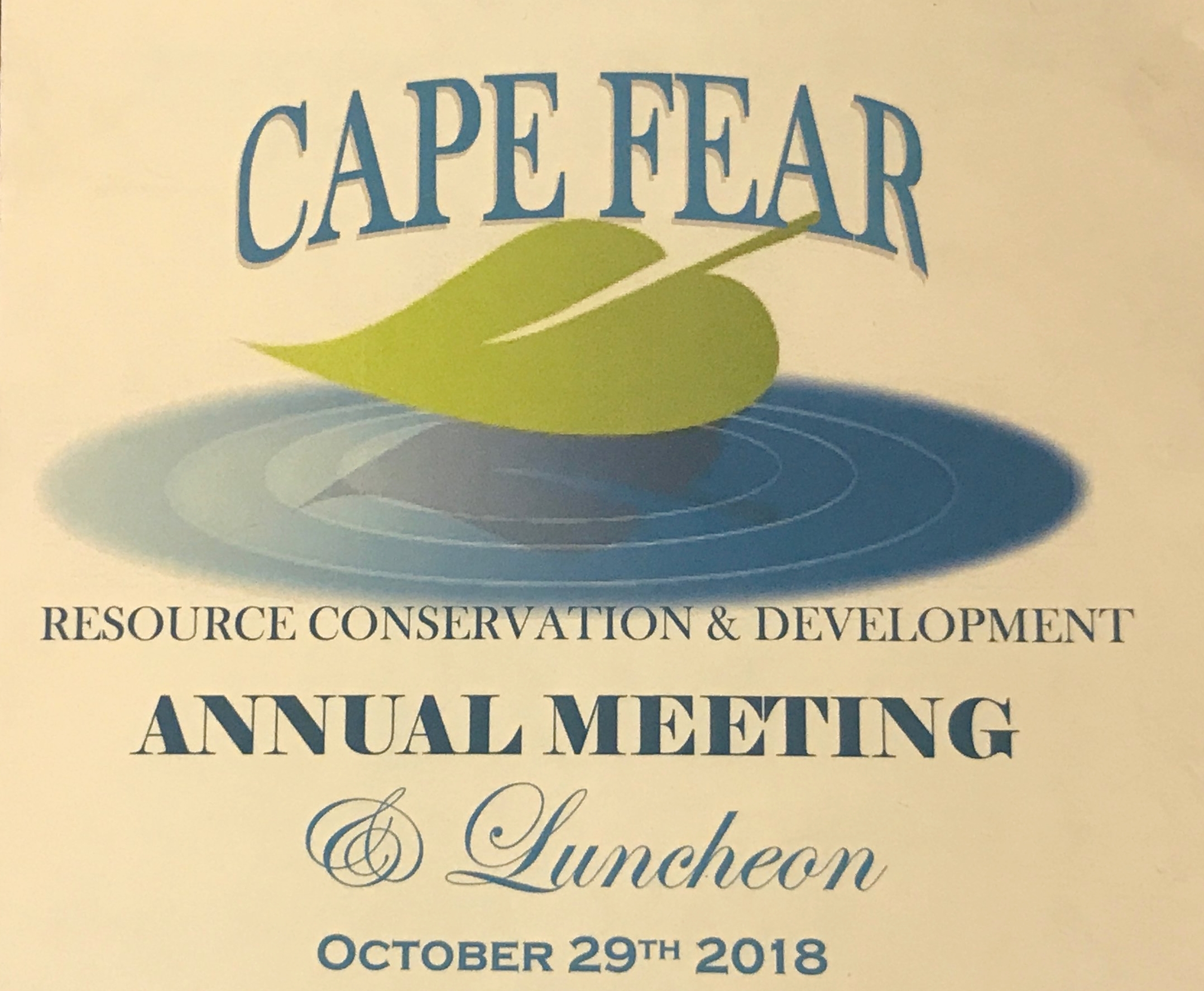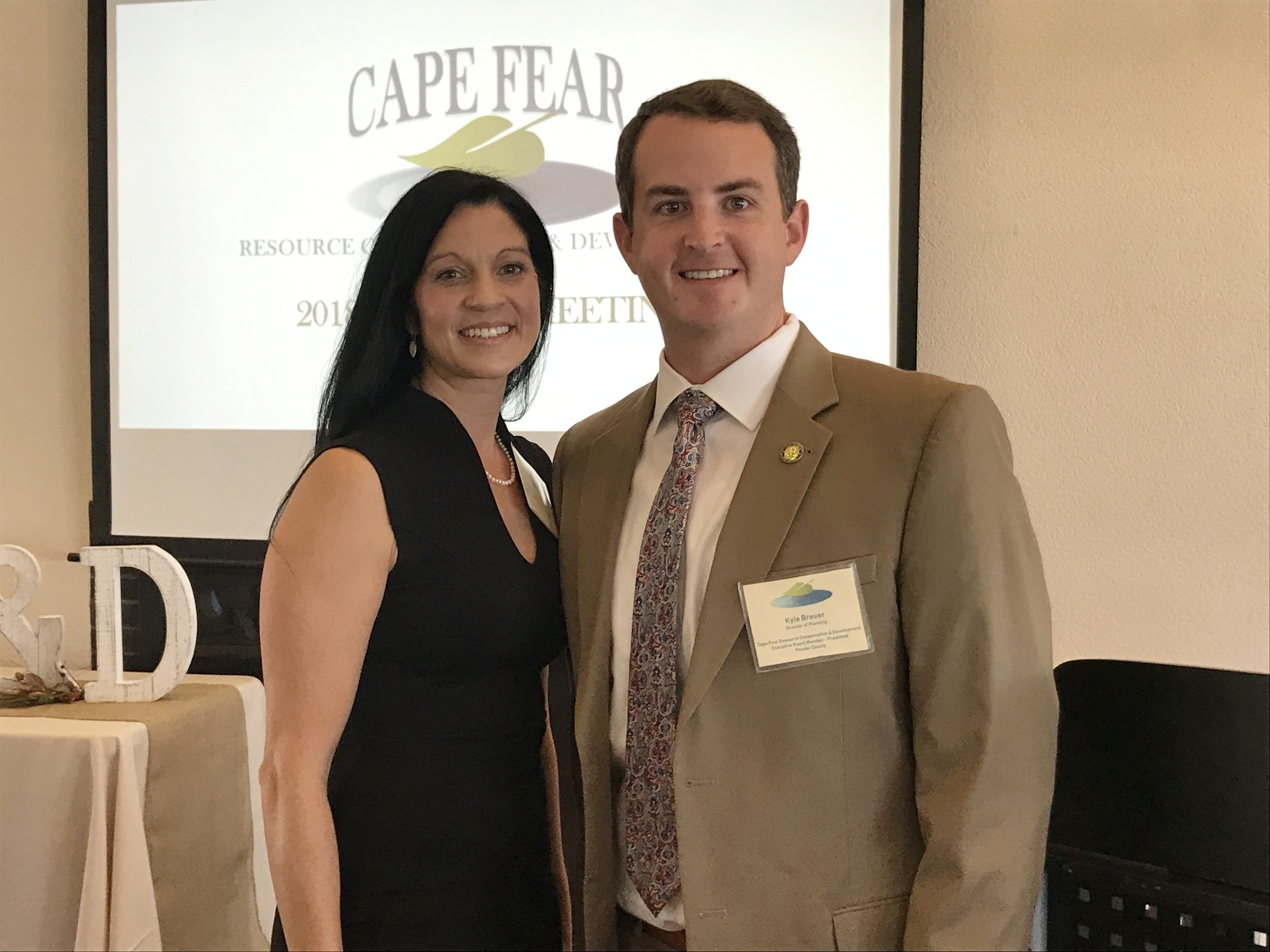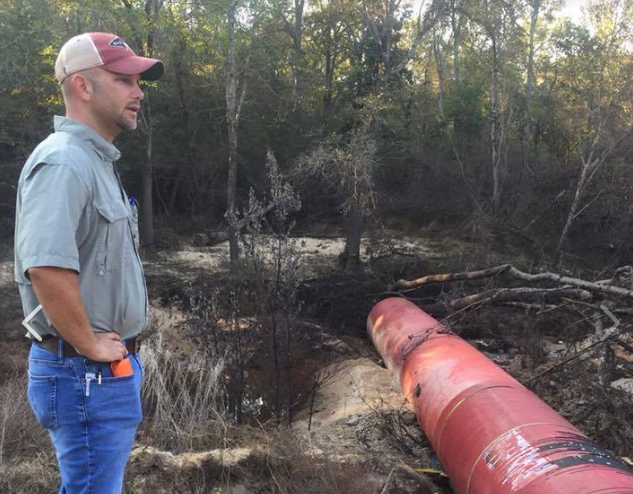The Cape Fear RC&D Annual Meeting was held Monday, October 29th at the Southport Community Building in Southport. N.C. Senator Bill Rabon for District 8 was the keynote speaker. The program included Hurricane Florence reports from Pender, Brunswick, New Hanover and Bladen counties and CFRCD project reports on aquatic activity in the Cape Fear River Basin, Regional Agriculture Center for Rescue and Education, Regional Barn Quilt Trail and Bladenboro Downtown Revitalization.
Dean Morris, Bladen County Soil & Water Conservation shares hurricane damage images
Dean Morris, Bladen County Soil & Water Conservation, shares images of Hurricane Florence storm damage.
LEE GANTT TO HEADLINE STORM BENEFIT CONCERT IN PENDER COUNTY
PENDER COUNTY, NC (WWAY) — A Nashville country singer will be the lead act in a concert benefiting local flood victims.
Lee Gantt has opened for some of the biggest names in the business including Chris Young, Dustin Lynch, and Colt Ford.
Lee Gantt will perform Saturday, November 10, at the Courthouse Square in Burgaw.
The “One Pender Hurricane Florence Relief Benefit Concert” will be held Saturday, November 10, at the Courthouse Square in Burgaw.
Admission will be by donation only.
Organizers say they were able to snag Lee because his drummer is the son of Pender County Emergency Management Director Tom Collins.
RC&D Councils StrikeForce Radio Shows
Local RC&D Councils in the USDA NRCS Designated StrikeForce regions have been working to increase NRCS outreach to historically underserved farmers and landowners.
RC&D Councils have developed radio shows that are relevant and meet the needs of underserved farmers and landowners using USDA program information and the local RC&D Council’s understanding of the customer. These radio shows are to inform underserved farmers and landowners on how to access USDA conservation assistance through the USDA StrikeForce for Rural Growth and Opportunity Initiative to address their natural resource concerns.
Commissioners learn about Cape Fear Resource Conservation and Development
By Erin Smith, BladenOnline.com
The Bladen County Board of Commissioners met on Monday night and learned about the Cape Fear Resource Conservation and Development, Inc. which specializes in natural resource conservation and economic development.
Kyle Brewer and Danielle Darkangelo with Cape Fear Resource Conservation & Development.
(Photo courtesy of BladenOnline.com)
Kyle Brewer and Danielle Darkangelo both addressed the board of commissioners. Brewer, who is the Executive Director for Cape Fear Resource Conservation and Development Inc.(CFRCD), told the board the group’s mission is to conserve natural resources while encouraging sound economic development and community development through project funding and implementation in southeastern North Carolina.
CFRCD is a non-profit organization that assists local governments and communities to carry out projects that will improve the quality of life, said Brewer.
CFRCD has helped Maple Hill in Pender County with a sewer project and has helped Pender County with the construction of an Ag Center/Livestock facility. Brewer said the livestock facility can accommodate large numbers of animals and can host shows and outreach programs.
Darkangelo spoke briefly about an affordable housing and revitalization project CFRCD is proposing for downtown Bladenboro. She also said the group is also working on aquatic activity in the Cape Fear River Basin. As part fo that, the group will focus on the Black River Basin with assessments of culverts in Bladen and Pender Counties. The goal of the project is to identify ways to decrease flooding, improve habitats and improve water flow.
In other business:
*The board conducted a public hearing regarding a rezoning request for tract located on Cromartie Road in Elizabethtown. The tract will be used for a commercial storage facility.
*The approved the Letter of Engagement and the audit contact with Thompson, Price, Scott Adams & Company for $38,300. The board also approved a Letter of Engagement for an audit of the Local Government Employees RetirementSystem accounts.
*The board adopted a resolution of support for the creation of a driver training facility to be located at the Law Enforcement Training facility at White Lake.
*The Commissioners also voted to approve Memorandum of Understanding with the United States Marine Corps to conduct training exercises in July at the Law Enforcement Training Center at White Lake.
*The board approved the Local Water Supply plans for East Bladen and West Bladen.
*The board approved a Memorandum of Understanding with the Nc Department of Public Safety, Division of Emergency Management regarding the Bladen County DRA 17 Hazard Mitigation project.
Livestock stranded after Hurricane Florence
Jewel Horton, Pender County Animal Shelter, with the help of North Carolina Department of Agriculture & Consumer Services, Pender County Animal Control and The N.C. Forest Service delivered food, hay and fresh water to livestock, chickens, dogs and cats stranded by Florence in the Lillington Lane and Honeysuckle Lane areas of Pender County by helicopter.
Several agencies collaborated to deliver food and fresh water to livestock stranded during Florence.
Owners without a livestock evacuation plan had to live animals behind.
NFWF Announces $700,000 in Grants to Help At-Risk Aquatic Species in the Southeast
WASHINGTON, D.C. (December 19, 2017) –The National Fish and Wildlife Foundation (NFWF) today announced $700,000 in grants to conserve and restore habitats for at-risk aquatic species within targeted freshwater ecosystems of the Southeast. The grants will generate $1.71 million in match for a total conservation impact of $2.41 million.
The grants were awarded through the Southeast Aquatics Program, a partnership between NFWF, the U.S. Forest Service and the U.S. Fish and Wildlife Service. The program this year is targeting two regions – the coastal watersheds of the Carolinas and the Apalachicola-Chattahoochee-Flint River Basin in Georgia and Florida. These watersheds were prioritized based on input from state wildlife action plans and the recently completed TN Aquarium and University of Georgia River Basin Center assessmen, which was funded by NFWF.
“The rivers and streams of the Southeast support the greatest diversity of freshwater species in the United States,” said Jeff Trandahl, executive director and CEO of NFWF. “This new program will help to safeguard these rare and at-risk species by improving the habitats they depend on.”
The five grants announced today will restore and enhance riparian and in-stream habitat, increase water flows and help landowners apply expert advice to more efficiently manage crop irrigation systems, saving water over traditional methods. In this inaugural round of funding, the projects are expected to:
- estore 2 miles of stream habitat
- Conserve over 830 cubic feet per second annually; that’s enough water to fill one Olympic sized swimming pool every 30 hours over the course of one year
- Prioritize more than 200 culverts and barriers for removal
- Develop protocols to detect mussels and their host fish using eDNA monitoring
“Forestland retention almost always complements watershed conservation, and these grants will empower private landowners to do their part to promote healthy habitats for these at-risk species,” said John Crockett, acting deputy regional forester for state and private forestry at the U.S. Forest Service. “Aquatic habitats are incredibly sensitive to environmental disturbances, but healthy forests can provide vital ecosystem service benefits and are critical in protecting water quality.”
This is the first year of the Southeast Aquatics Program. The program is designed around a habitat-based approach, benefiting a diversity of species and reducing the likelihood of future listings under the Endangered Species Act for at-risk species. This funding opportunity is expected to expand in its second year with the U.S. Department of Agriculture’s Natural Resources Conservation Service slated to join the funding partnership.
“These projects will contribute significantly to conservation of priority fish, mussels and other aquatic wildlife in the Apalachicola-Chattahoochee-Flint River Basin and in coastal watersheds across North and South Carolina,” said Mike Oetker, acting regional director for the U.S. Fish and Wildlife Service’s Southeast Region. “Anyone who has ever floated these rivers or been shin deep in them with a fishing rod knows how incredible these places are and the conservation work being announced today with strong partnerships will only make them better.”
To learn more about the Southeast Aquatics Program or to download the 2017 Southeast Aquatics Program grant slate, visit www.nfwf.org/seaquatics.
About the National Fish and Wildlife Foundation
Chartered by Congress in 1984, the National Fish and Wildlife Foundation (NFWF) protects and restores the nation's fish, wildlife, plants and habitats. Working with federal, corporate and individual partners, NFWF has funded more than 4,500 organizations and committed more than $3.8 billion to conservation projects. Learn more at www.nfwf.org.
Columbus County — Natural Resource Protection and Environmental Education—Lake Waccamaw State Park
Superintendent Toby Hall looks forward to opening up the Bay Forest to park visitors. The trail will also provide a shortcut back to the park’s visitor center for those needing a shorter distance.
The Bay Forest habitat type within Lake Waccamaw State Park will be opened up to park visitors following the completion of a 500’ boardwalk trail linking the Lake Shore and Pine Woods Trail.
Cape Fear RC&D was awarded a $15,400 N.C. Recreational Trail Program grant to build the boardwalk. International Paper’s Reigelwood Community Foundation is assisting the project through a $1,000 contribution.
A significant reduction in construction and materials costs was pledged by Trigon of Whiteville, Inc., a company the park has worked with in the past.
Park Superintendent Toby Hall looks forward to providing hikers a shorter loop trail option to get back to the visitor center. It will be a two mile walk rather than the current five mile trek.
Lake Waccamaw is one of hundreds of Carolina bays in North Carolina. The term “bay” does not refer to a body of water but a natural basin whose name originates from the fact that there is an abundance of sweet bay, loblolly bay and red bay trees growing beside the watery, oval depressions in the earth.
The boardwalk was started by a local boy scout who was unable to complete the project a few years ago.
The park’s interpretive program will be enhanced by this addition to its nature study offerings. Bird hikes, tree identification and wildlife observation programs will be possible with he new boardwalk.
The trail should be completed by early summer, 2014. We look forward to its formal dedication.
Bladen County — Farmland Sustainability — No-till Grain Drill
The Bladen County no-till grain drill prevents soil erosion and lessens sedimentation and nutrient loading in streams
Cape Fear RCD provided support for the acquisition of a 10’ John Deere no-till grain drill being used by limited resource farmers in Bladen and Columbus Counties. Dean Morris, NRCS Natural Resource Conservationist reported that this fiscal year, 27 “customers” planted 965.7 acres using the grain drill. The no-till drill helps prevent soil erosion and significantly cuts down on sedimentation and nutrient loading in streams and rivers. Small farmers with smaller tractors and wildlife enthusiasts interested in planting food plots are renting the grain drill at a small per-acre rate from the Bladen Soil and Water Conservation District. Seasonal crops such as small grains and sorghum can be planted using the grain drill. Rental income is being used to maintain the drill.
Riegelwood will be home to Cape Fearless Extreme
Envalish sent nationally certified arborist Randy Pound to measure and evaluate the trees that could become part of the course.
Ron England of Envalish Recreation, LLC, plans to provide a place for children and adults to play on swings, zip lines and climbing apparatus while enjoying a natural, wooded setting. England is working with internationally known building firm Outplay Adventures to build the region’s newest aerial adventure park, Cape Fearless Extreme, close to Riegelwood.
Outplay Adventures has built 16 aerial parks in the U.S., plus “three or four in Canada,” England estimated, “five or six in Europe and some in China and the United Arab Emirates.”
England received word Tuesday that his permits from the county had all been signed. Building materials are being delivered daily, and his eight building crew members have been pruning and cleaning up along the course since last week. “Life is good,” he said.
Years of planning
Envalish Recreation chose the site close to the Brunswick County line very carefully, looking in areas that were close to busy tourist destinations but that were not yet saturated with development. Riegelwood’s proximity to busy beach routes made it favorable.
“Then we looked at population centers,” England said. Company officials hope to attract year-round guests who may not be on vacation but who are willing to make a day trip from places such as Fayetteville and Wilmington.
Planners also considered the presence of colleges, universities and military installations within a reasonable radius.“Then we looked at the places on the map where all those circles overlapped,” said England. Riegelwood became the frontrunner for the new construction location. The company asked a Wilmington real estate agent to screen pieces of land meeting specific criteria. Crucially, said England, “We had to choose a place with the right trees.
“Two years ago we came down and looked at about 20 properties,” England continued. When he and his partners toured the tract on Neils Eddy Road, bordering the Cape Fear River, “We kind of fell in love with it,” he said.
Envalish sent nationally certified arborist Randy Pound to measure and evaluate the trees that could become part of the course. Pound said that 95 percent of the trees he examined were loblolly pines. He was looking for large trees with strong root bases and sound trunks free of cavities. He was pleased to find “an abundance of good, healthy trees.”
Pound is an expert in tree preservation. Decay or disease would eliminate a tree from being part of the course. “Our livelihood depends on the health of the trees,” said England. “If he (Pound) says a tree isn’t good, it’s out of the equation.”
Unlike many aerial parks that are built on poles, the Cape Fearless course will be supported by living trees, and Envalish takes great efforts to avoid injuring them. Pound and England described how wooden platforms will be clamped to tree trunks using adjustable threaded bolts that allow park engineers to adjust the compression as the trees grow.
During construction, “there is no heavy equipment rolling over the tree roots because that compacts the roots, and trees can die from compaction,” England said. Crew members use no spikes on their shoes as they walk up the tree trunks carrying their building materials.
Watching experienced builder Todd Clear hoist himself up a pine tree, England said, “Todd makes it look easy, but it takes a lot of strength and coordination.”
Natural setting
By avoiding large machinery or other potentially damaging methods, England and the crew are investing extra muscular effort in construction so that park users can enjoy maximum shade along the course.
“We know summers here are brutally hot,” England said. He pictures Cape Fearless becoming a retreat from the sun for travelers who are sunburned or “beached out.”
Wildlife will still have plenty of room in the brush alongside the course, too.
Readers who have tackled the aerial obstacle courses at Shallotte River Swamp Park may wonder how Cape Fearless compares. England said that Cape Fearless will offer similar components, but in a “more linear” layout.
“There are different types of parks, but no one is really better than the other,” said Chris Sherry, another manager on the project. Sherry is the member of the team who suggested the name Cape Fearless Extreme. The Shallotte River park more or less spirals up with one course above another within a small footprint. At Cape Fearless, “you can get lost in the woods,” he said.
Safety
Of course Sherry only means that the visitors to Cape Fearless can experience the pleasant sensation of being surrounded by woods as they climb, crawl and zip deeper into the property. The adult course will be over half a mile long. With guides stationed along the way, no one is actually going to get lost.
Envalish is serious about safety. Visitors really can be fearless as they step out onto a wobbly bridge or grab hold of a zipline: each person on the course is securely belted into a body harness suspended from a stout overhead steel logging cable. It is impossible to fall off the course, and any guest who behaves unsafely toward another is subject to immediate eviction from the park.
The support cables have a breaking strength of over 24,000 pounds, or the weight of two school buses. “The trees and the cables don’t even know” when people are climbing on the course, England said.
In fact, Pound pointed out, the cables will help to stabilize the trees in windstorms. Hurricanes Sandy and Maria destroyed many of the trees along the sides of similar courses in Pennsylvania and Florida, but none of the cable-secured trees came down.
Once platforms, cables and obstacles are in place, England said, crew members will test the courses multiple times a day for several weeks to make sure that users ranging from 70 pounds to 300 pounds can safely navigate the course’s angles. “We want people at both ends to move at the safe, right speed,” he said.
Cape Fearless Extreme’s website specifies participant age and height requirements and the following dress regulations: Sturdy shoes with closed toes are a must. Jewelry and other dangling items are discouraged. Clothing should be appropriate for the weather conditions and should fit close to the body. Long hair needs to be pulled back. In other words, a trip to Cape Fearless will be an opportunity to leave your cell phone and high heels in a locker and go act like a kid again.
“Our reservations are rain or shine,” says the park’s website, www.capefearless.com. Zip-lining and playing among the treetops are actually “more fun in the rain,” England and Sherry said, “especially if it’s hot.” Thunderstorms are another matter, however.
Park personnel monitor weather all day and are prepared to evacuate visitors at any sign of danger. At the company’s Skytop Lodge course in Pennsylvania, said Sherry, “we’ve evacuated 140 or 150 people out of the trees in 10 minutes. We had to get them down off the upper slope of the mountain, too.” Speed evacuation skills will be a prime objective during employee training.
Guests who are evacuated from the wires due to lightning will be allowed to resume climbing once the danger is past.
In addition to performing mass evacuations, all guides on the course must become able to scramble up a pine tree using ropes and bring down an individual guest who for whatever reason becomes incapable of going forward.
Participants ages 10 and up will climb over obstacles, cross swinging bridges and hang from overhead rings as they progress through a series of four mid-air obstacle courses.
The courses become more challenging and higher off the ground along the way. Users may complete all four courses or may return to earth at the end of any one of them, but they may not return to the course once they come down.
A separate kids’ area will include scaled-down obstacle courses closer to the ground for children ages 7-11. Children, unlike adults, may go through the course twice for one admission ticket.
“We want to give people the kind of fun experience they had as children, swinging and climbing in the trees, with no danger except getting a little sore,” England said. “We want to give people the chance to be successful. If we wanted, we could make our courses so difficult that only the most fit and confident people could finish them. But what good would that do? We want to make something that most people – if they try – can finish.”
“Even a person who’s afraid of heights, and they go up and just do the green course, then come down, that’s a success,” England said. “It’s all about success.”
Cape Fearless Extreme will open April 14, and it is already possible to make online reservations. Admission is a splurge, at $25 per user on the children’s course and $47.50 per user on the adult course, Monday through Friday. The adult course costs $50 on Saturday and Sunday. Season passes will be available that will make the cost per visit lower for those who want to return several times in one season.
England said that he and his partners “have been embraced up and down the road,” receiving “a lot of local support” over the past year. They want Cape Fearless to be “very active with the community.” As a special early-season offer, they will give a 10 percent discount on visits by Columbus County residents who reserve by March 1 and visit the park between mid-April and mid-May. The word “COLUMBUS” will be the code word to take advantage of the savings.
England estimates that Cape Fearless will have a year-round full-time staff of three or four people, with a year-round part-time (weekend) staff of another five or six and as many as 20 working through the busy summer season.
Cape Fearless will be located at 1571 Neils Eddy Rd. in Riegelwood. The phone number is (910) 854-0545. The email address is info@capefearless.com.



















